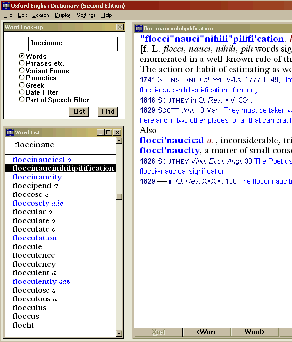

Photo by Christoffer Engström on Unsplash
Do you have a dictionary lying around? Do you remember the last time you held one in your hands and paged through it, searching for a word you wanted to look up? If you’re like me, it’s been a while! Somewhere along the way,
we stopped using dictionaries to look up words. Today we simply type the word into a search box or ask a voice assistant. We get the same outcome (finding the word’s meaning), but the journey and the tool (dictionary) we used have disappeared from view.
The current boom of generative AI is beginning to transform our digital experience to such an extent that what we think of “UX” will disappear. Like the dictionary and the act of looking up words, many patterns and paradigms we currently use will become faint memories.

User experience, or UX, is the art and science of creating journeys that allow users to find and use digital resources. One way to think about UX is as digital wayfinding.
Let’s consider an example from the real world. Say you wanted to renew your driver’s license. You’d first need to determine that you need to visit your local Department of Motor Vehicles.
When you enter the lobby of the DMV, you’ll encounter signs helping you find the right clerk to access the service you need. The clerk will find the correct form, have you fill it out, and process it.
Surprisingly, the digital version of this journey isn’t very different. You’ll search for the DMV’s website and be there instantly. Once on the DMV website, you must find the proper form and fill it out.
In the physical world, a clerk produces the correct form by asking you questions. In the digital world, you’ll have to follow the links to the right section and locate the document.
The website navigation, UI elements, description, etc., constitute the website’s user experience.
When we began designing digital experiences, we modeled them after the physical world. We employed concepts such as files and folders to represent digital collections of ones and zeros. Keeping the same models made the transition to the digital realm easier. This design concept of mimicking the physical world in digital experiences is called skeuomorphism. Apple was a major proponent of this, as seen in the image below.

(image credit Apple Insider. IOS 6)
Fundamentally we’re recreating our physical journey in the digital world. We navigate the web searching for information, forms, and resources, just as we would navigate a physical space to find the right clerk. We often find ourselves hopping from one window to another, from one app to another, constantly converting information to fit the format of each app. When we get stuck, the help documentation can be different from what we see on the screen, leaving us feeling lost.
There has been a boom in building digital experiences, with the average company deploying around 110 applications (per Better Cloud survey), resulting in digital journeys that often cross apps, requiring us to reacquaint ourselves with the wayfinding in each app. We take email copy from a Google Doc, copy it into Hubspot for sending a marketing email, and track results in Mixpanel. It’s like we’re rats in a digital maze, finding our way from one resource to the next, constantly switching from one app to another, each with its distinct UX, colors, and navigation scheme.

Théo Guignard, Labrynth
All of this switching comes at a cost. Research from RingCentral in 2018 revealed that employees switch between apps an average of 10 times per hour, resulting in a yearly loss of up to 32 days of productive work. (CMSWire)
However, a revolution is on the horizon that will transform this experience. In this future, the digital journey won’t just improve. It will vanish. Enter generative AI. Imagine if an app could be generated to fit the user’s needs in real-time. Instead of navigating the digital maze, searching for each resource, and piecing together the solution, the proper form appears based on our needs.
Are you curious about what this transformation could look like? You’ve already lived through one. Let’s look at how the journey to look up words has become a thing of the past.
“The prosaic, dog-eared nature of dictionaries belies the fact that the books are consistent nonfiction best-sellers. Merriam-Webster of Springfield, Mass., says it sells more than a million copies a year. First appearing in 1983, it has been a fixture on The New York Times best-seller list for 155 weeks and shows no signs of wilting.”
NYTimes, 1988, ‘The Dictionary as a Blockbuster’
Just a year after this 1988 article was published in the New York Times, Tim Berners-Lee proposed the concept of the World Wide Web. Around this time, a Gallup survey found that 89% of households owned a traditional dictionary, with 32% also owning a foreign-language dictionary and 20% a crossword puzzle dictionary.
As the Internet grew in popularity, Merriam-Webster adapted. They offered CD-ROM versions of their dictionary, which included a one-year subscription to an online dictionary in 2009. They had sold 55 million copies of their print dictionary and believed the world would become hybrid. Despite the shift to digital, John Morse, President and Publisher of Merriam-Webster, noted that “We live in a hybrid world, part print, part electronic,” and that the two were “mutually reinforcing.”

Merriam-Webster CD-ROM (source: Wikipedia)
Fast forward to 2011, Apple shipped a dictionary built into iOS 5, making it easy to find definitions without navigating to a separate app. Today, dictionaries are seamlessly integrated into the workflow, with the ability to select a word and get a definition with a simple right-click. For a keyboardless experience, ask Siri or Google.
The journey to look a word up has disappeared.
Of course, dictionaries and dictionary apps are still around. If you want to delve into the origin of a word or explore its synonyms, they provide the best experience. However, you no longer need to break your workflow to find the definition of a word or even translate a sentence into another language.
The dictionary is a prime example of how the user journey has evolved. Initially, these changes only applied to information lookups, such as weather and movie times. As algorithms became sophisticated, we could issue commands like “Lunch with Scott on 2/14 at 2 pm,” and our calendar would create the meeting, eliminating the need for multiple clicks, drags, and button presses.
Now, we are on the brink of even more significant changes. For instance, in apps like RunwayML, a video editing tool, you can simply ask for a video clip to be color graded to look like Pulp Fiction by typing in instructions. Previously, this would have taken more time — the manual effort of tweaking, comparing, and adjusting has dramatically reduced. But more importantly, the expertise needed has changed. Today, the user’s creativity (“Pulp Fiction style color grading could look good!”) is gated by knowledge of video editing software. AI is sweeping away those constraints.

RunwayML demo video
The future is here, just unevenly distributed.
William Gibson
AI can potentially change how we create user experiences by generating customized interfaces for each user. This means that users can ask for the tools they need when they need them, making complicated tools incredibly easy to use.
For example, if users don’t like the colors in an image editing software, they can ask for a tool to change the colors without navigating through menus or settings. These new bespoke apps will need a new way of thinking about UX.
Are you curious to see how it will evolve? I am too! Keep an eye on this space to continue the journey into questions like:
What requires us to build software as we do today?
When a customer journey disappears, what does digital wayfinding look like?
What tools and SDKs are needed to build this new vision of software?